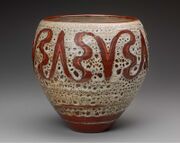Difference between revisions of "Albany slip clay"
Jump to navigation
Jump to search
| (2 intermediate revisions by 2 users not shown) | |||
| Line 1: | Line 1: | ||
| + | [[File:Albany slip MFA20121107.jpg|thumb|Underglaze of Albany slip<br>MFA# 2012.1107]] | ||
== Description == | == Description == | ||
| Line 7: | Line 8: | ||
slip glaze | slip glaze | ||
| − | + | == Physical and Chemical Properties == | |
| − | |||
| − | |||
| − | |||
| − | |||
| − | = | + | * Melting Point = 1240 C |
| − | + | ==Resources and Citations== | |
| − | |||
| − | == | ||
* Ralph Mayer, ''A Dictionary of Art Terms and Techniques'', Harper and Row Publishers, New York, 1969 (also 1945 printing) | * Ralph Mayer, ''A Dictionary of Art Terms and Techniques'', Harper and Row Publishers, New York, 1969 (also 1945 printing) | ||
Latest revision as of 16:25, 1 May 2022
Description
A dark, fine-grain clay obtained from near Albany, New York. Albany slip contains silicon dioxide (57.6%), Aluminum oxide (14.5%), Calcium oxide (5.7 %), iron oxide (5.2%), Magnesium oxide (2.7%) and various alkalis (3.1%) (Fournier 1996). The dark brown to black clay was used by early American potter's as a black glaze for stoneware. It was often applied to the interior of salt glazed stoneware.
Synonyms and Related Terms
slip glaze
Physical and Chemical Properties
- Melting Point = 1240 C
Resources and Citations
- Ralph Mayer, A Dictionary of Art Terms and Techniques, Harper and Row Publishers, New York, 1969 (also 1945 printing)
- Robert Fournier, Illustrated Dictionary of Practical Pottery, Chilton Book Company, Radnor, PA, 1992 Comment: composition
- Art and Architecture Thesaurus Online, http://www.getty.edu/research/tools/vocabulary/aat/, J. Paul Getty Trust, Los Angeles, 2000
